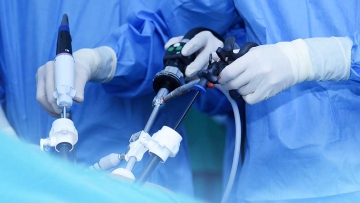Understanding Laparoscopy
Laparoscopy, sometimes referred to as keyhole surgery, is a minimally invasive surgical process carried out through tiny abdominal wall incisions. The surgeon inserts a laparoscope, a small, illuminated tube with a high-resolution camera at one end, into the abdomen to precisely view and examine the pelvic and abdominal organs.
Diagnosis of Infertility
In the context of infertility, laparoscopy plays a crucial role in diagnosing various underlying conditions that may hinder conception. These conditions include:
- Endometriosis: Endometriosis is a common condition where tissue similar to the uterine lining grows outside the uterus, leading to inflammation, adhesions, and scarring. Laparoscopy can accurately identify and stage endometriosis, enabling timely intervention and improved chances of pregnancy.
- Pelvic Adhesions: Scar tissue and adhesions in the pelvic region can result from previous surgeries, infections, or endometriosis. Laparoscopy for infertility helps identify these adhesions and allows for their removal, restoring normal pelvic anatomy and function.
- Ovarian Cysts: Laparoscopy enables the evaluation and removal of ovarian cysts that might be affecting ovulation or hormone balance.
- Tubal Patency: Blocked fallopian tubes are a common cause of female infertility. Through laparoscopy, doctors can examine the fallopian tubes and even perform tubal cannulation to open blocked tubes, increasing the chances of natural conception or IVF success.
Treatment of Infertility
In addition to helping with infertility diagnosis, laparoscopy surgery for infertility treatment offers options for therapeutic interventions:
- Ovarian Drilling: Anovulation is a possibility in women with Polycystic Ovary Syndrome (PCOS). Small holes are drilled into the ovaries during a surgery called laparoscopic ovarian drilling, which can increase fertility and encourage ovulation.
- Endometriosis Excision: Laparoscopic excision of endometrial lesions can reduce pain and enhance reproductive outcomes for women with moderate to severe endometriosis.
- Myomectomy: To assist restore normal uterine function, laparoscopic myomectomy removes uterine fibroids, which can restrict the uterine cavity or interfere with implantation.
Laparoscopy For Infertility
Laparoscopy surgery for infertility treatment can help diagnose and treat several ailments:
- Diagnosis of pelvic conditions: Laparoscopy is regularly performed to analyse and diagnose various pelvic issues that might be connected with infertility. These afflictions include endometriosis, fallopian tube anomalies, pelvic adhesions, Pelvic Inflammatory Disease (PID), ovarian cysts, and uterine fibroids.
- Treatment of pelvic problems:After a laparoscopic diagnosis is made, a few pelvic conditions might be dealt with simultaneously with the surgery. For example, endometriosis lesions, adhesions, and ovarian cysts can be surgically removed. Correcting these conditions can further facilitate favourable results.
- Fallopian tube evaluation and repair: Laparoscopy can assess the patency and health of the fallopian tubes. Surgeons may try to repair or unblock the tubes if blockages or abnormalities are found to increase the likelihood of a natural pregnancy.
- Ovarian drilling: Laparoscopic ovarian drilling is a surgical treatment to treat anovulation (lack of ovulation) in women with Polycystic Ovary Syndrome (PCOS). To encourage ovulation, the treatment includes producing tiny punctures in the ovaries.
Advantages of Laparoscopy
Some of the key benefits of laparoscopy include:
- Enhanced visualisation: An improved visual examination of the pelvic anatomy is possible thanks to the high-definition, magnified images of the reproductive organs provided by laparoscopy.
- Minimally invasive:Laparoscopy is minimally invasive; it just requires minor entry points instead of a normal open-for-surgery procedure, which causes less tissue harm and postoperative pain and ensures faster recovery. Patients typically experience less scarring and have a quicker return to normal activities.
- Reduced risk of complications: The smaller incisions used in laparoscopy reduce the risk of infection and other surgical complications. Additionally, the use of carbon dioxide gas for insufflation during the procedure helps separate the organs, reducing the risk of inadvertent injury.
- Shorter hospital stay: Compared to open surgery procedures, laparoscopic therapies are regularly led as short-term procedures or need a shorter hospital stay, which results in financial savings and a quicker recovery compared to traditional surgical methods.
Conclusion
Laparoscopy has revolutionised the diagnosis and treatment of infertility, offering significant benefits over traditional open surgery. Its minimally invasive nature, accurate diagnosis, and improved treatment options have transformed the way infertility is managed. By providing a more precise understanding of reproductive abnormalities and enabling timely interventions, laparoscopy has increased the chances of conception and pregnancy for countless couples worldwide. As medical technology continues to advance, laparoscopy will undoubtedly play an increasingly vital role in shaping the future of infertility treatment and reproductive medicine.

